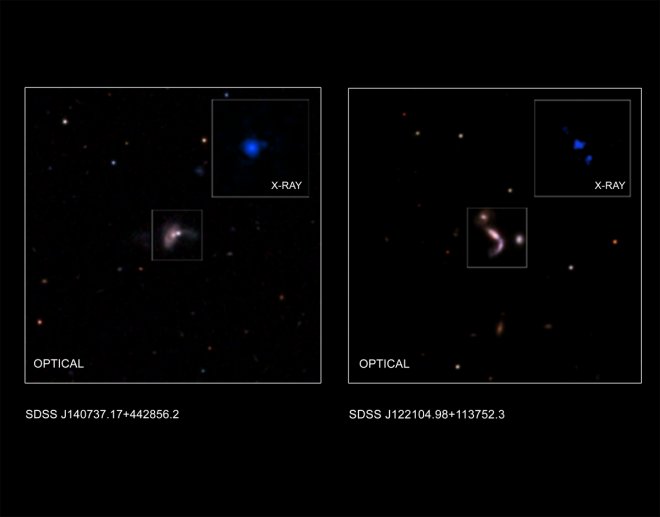
Astronomers have succeeded in merging five pairs of supermassive black holes by combining data from observatory telescopes. This merger is believed to be the greatest opportunity for the scientists to view the growth of giant black holes. The gravitational waves signals produced from it would be the strongest ever experienced by the researchers.
NASA's Chandra X-ray Observatory, the Wide-Field Infrared Survey Explorer (WISE), the ground-based Large Binocular Telescope in Arizona, and the Sloan Digital Sky Survey (SDSS) Mapping Nearby Galaxies at APO (MaNGA) survey made the crucial discovery for space science.
Shobita Satyapal, a lead researcher from the George Mason University in Fairfax, Virginia said, "Astronomers find single supermassive black holes all over the Universe. But even though we've predicted they grow rapidly when they are interacting, growing dual supermassive black holes have been difficult to find."
The researchers say that each black hole among these five pairs has masses which are millions of times the mass of the sun. The black hole couples are formed when two galaxies merge to form a larger galaxy. It brings their gigantic black holes to pair at the center of the newly formed galaxy. Giant Black holes are known to be located at the center of the galaxies.

The researchers of the Sloan Digital Sky Survey (SDSS) identified merger of two smaller galaxies using their optical data from the Galaxy Zoo Project, which studies the galaxy formations. They selected galaxies which are separated in less than 30,000 light years using the SDSS data. Infrared data from the WISE was used to predict the rapidly growing massive black holes.
They found that seven merging systems contained at least one massive black hole in its center. The research team led by Shobita Satyapal at the Chandra X-ray Observatory found five galaxy systems which had closely separated paired X-ray sources. These X-ray sources were indeed the paired black holes which were in the process of their merger. Chandra's data also showed that merging black holes contain large amounts of dust and gas.
Sara Ellison of the University of Victoria in Canada, who led a research, said, "Our work shows that combining the infrared selection with X-ray follow-up is a very effective way to find these black hole pairs. X-rays and infrared radiation are able to penetrate the obscuring clouds of gas and dust surrounding these black hole pairs, and Chandra's sharp vision is needed to separate them."
The MaNGA survey had also helped in finding a new pair of black holes. Research paper of Sara Ellison states that it had one of the most powerful black holes observed.
Laser Interferometer Gravitational-Wave Observatory (LIGO) and the VIRGO interferometer had earlier detected signals from smaller black holes which weighed between 8 and 36 times the mass of the Sun.
The merging of supermassive black holes would generate large quantities of energy. Some of the masses would be converted to huge volumes of gravitational waves. Gravitational waves would be produced when the black holes move nearer.
The detection of gravitational waves has significant importance in the astronomical studies. The merger of the neutron stars was observed recently by scientists through detection of these gravitational waves. Scientists said that this neutron star merger has resulted in the formation of a black hole. The Nobel Prize 2017 for Physics was awarded to Rainer Weiss, Barry C. Barish, and Kip S. Thorne for detection of the gravitational waves.
Shobita Satyapal said, "It is important to understand how common supermassive black hole pairs are, to help in predicting the signals for gravitational wave observatories. With experiments already in place and future ones coming online, this is an exciting time to be researching merging black holes. We are in the early stages of a new era in exploring the Universe."









